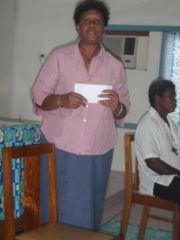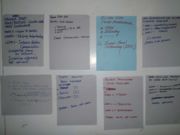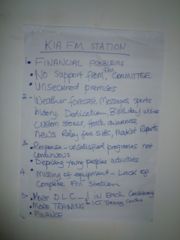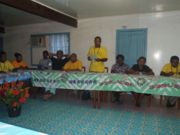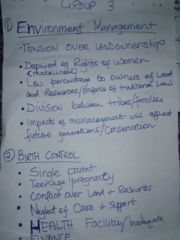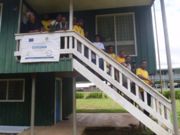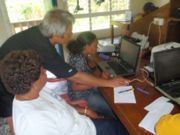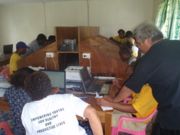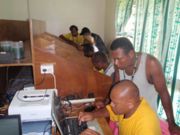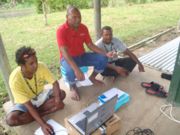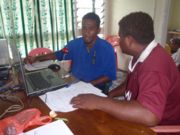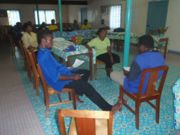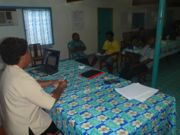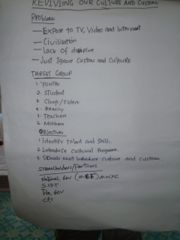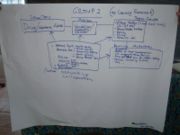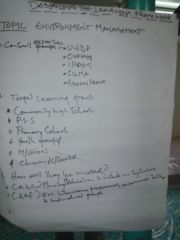Learning4Peace/Solomon Islands/workshop 1 outputs
Contents
Day 1
Project page with links to workshop objectives and schedule
Activity 1 Outcomes
Words to describe participant's expectations:
- Talent
- Training (7)
- Improvement
- Knowing and Understanding
- Communication (5)
- Connect
- Exposure (2)
- Concentrate
- Learning (2)
- New (2)
- Interesting (2)
- Up-to-date
- Skill (5)
- Listen
- Build
- Trainers
- Youth (2)
- Framework
- Network
- Know to handle
- Edifying Understanding
- Improve relation communication
- First of it's kind
- Challenging
- Practical
Suggested network names
- Isabel Network (3)
- Bugotu Network
- Empower Isabel Youths Network
- The Gema Network (2)
- Isabel Language Network\
- Isabelian Approach Fast Network
- Isabel Youth Connect
- Isabel Youth Network (2)
- Isabel Communication Network
- Isabel Rural Networking
- Isabel Link Network
Activity 2 – Outcomes
| Group 1 - Kia | Group 2 - Tatamba | Group 3 - Sigana | Group 4 - Susubona | |
| How well are the FM stations working?
|
Operating; | Operating 2 years; 2 full time staff; FM station works very well. | Quite good but needs to improve;
|
Worked well until it broke down Dec 2008; |
| What problems? | Financial problems;
No support from committee; Insecure premises; Some equipment missing; |
Charges, restriction to use, limited resources/access, distances, few radios. | Technical problems can not be solved quickly; Programmes are not properly arranged; Financial | Machines down; |
| What kind of programming? | Weather forecasts, Messages, Sports, History, Dedications, Birthday wishes, Custom Stories, Health Awareness, News relay from SIBC, Market Reports | Music (dominates); Messages (not often); Awareness (nil); Announcement only; Custom stories (nil); | Music, sports, health talk, educational, messages, requests. | Mostly music, some messages and news; |
| How is the community responding? | Unsatisfied (because) programmes not continuous;
Depriving young people's activities |
Poor response/lack of knowledge; Youth service unfriendly; Few radios (expensive batteries needed to listen to FM) | Exciting – information can be translated to local languages; Can reach all villages (availability). | No feedback; |
| How can we improve networking using the FM? | More DLCs needed, one in each constituency;
More training; ICT training centre; financial support. |
Proper housing; More training; Balance the music varieties. | Fix the machines and youth an women must participate actively. |
Activity 3 – Outcomes
Identifying Priority Themes for Youth Networking
This activity proved to be difficult and after discussion the activity questions were rephrased as follows:
- Discuss the priorities of the youth Policy and identify one or two related themes (issues) that you think will be good subjects for piloting a youth-led community learning programme.
- Can you break down your selected theme(s) further, into specific problems that can be addressed?
- What will be the objectives of the learning programme(s), and can you suggest how the learning might take place?
Three examples were given before the group work took place:
- The “You Will Know” DVD of the “Brothers Against Violence” Maori Youth group was played. The Isabel Youth network might collaborate to create similar songs and lyrics based on the selected themes, and even involve popular Isabel music groups to record them. The DVD shows that video might also be used in due course, although audio would currently reach more people.
- SIDT has a Youth Success Stories project in their Youth and Mental Health programme.
- At an SIDT workshop last year, it was identified that rapidly changing culture is an issue with the traditional leaders, who are alarmed also by incorrect information about Isabel being made available externally. A Youth-led community learning programme might explore this through interviews with chiefs, archiving of chiefly knowledge, discussion and debate on the FM network, and creation of web resources about Isabel to provide correct data and to affirm and conserve Isabel culture and values.
| Themes | Specific Problems | Objectives and Learning process | |
| Group 1 | Reviving our culture and customs | Western influences; Imitating | Liaise with chiefs for awareness programmes; Interviewing the communities how these cultures and customs can be revived (recording interviews); Identify the strengths and weaknesses; Impose strong discipline (regarding customs) |
| Group 2 | Drugs and Substance Abuse | 1. Domestic violence;
2. Vandalism/disorderly; 3. Youth mental health; 4. Study-disturbance/learning; 5. Teenage pregnancy; 6. Child abuse. |
Youth success stories (connects with 3);
Dramatise issues, i.e. Dance with the devil programme (connects with 1,5,6); Youth talk-back show; Zingles awareness adverts (as with quit smoking) |
| Group 3 | 1. (Poor) environmental management (natural resources)
|
Tension over (women's) land ownership; Deprived of rights of women (matrilineal); Low percentage to owners of land resources; (need to) enforce traditional law; Division between tribes/families; Impacts of mismanagement will affect future generations (conservation).
Single parents; Teenage pregnancy; Conflict over land and resources; neglect of care and support; Health facilities/inadequate. |
|
| Group 4 | 1. Urbanisation/drift;
2. Alcohol and drug use 3. The Youth Policy and Action Plan |
Lack of employment; Extra mouths to feed (in town); Inactive leads to criminal activities;
|
Community-based vocational learning; Initiate economic projects in villages (learning can be about these); Initiate interesting youth programs to attract youths to stay; Educational awareness programmes to highlight the problems; Interview youths returning from town/ compare stories with those who stayed;
Carry out educational awareness programme about the issues highlighted in the Youth Policy and Action Plan |
The participants then confirmed and agreed that that the results above can be developed further into more detailed learning frameworks, to be carried forward and developed in Phase 2, through the Youth networking and collaboration.
Notes:
- expand on environmental management / women vs chiefs, women viewed as honest because of responsibilities
- Groups checked the ideas were consistent with youth policy
- feedback: IPYC: very attractive to IPG because this can be a very efficient way of awareness raising, compared to physical travel
- Stories can be dramatised and serialised for FM radio, “home and away” Isabel style for radio...
- Important to link IPG rural development policies to community learning (i.e. rural youth opportunities)
Day 2
Community media networking tools - hands on experience
The Youth coordinators traveled to Guguha DLC and spent the day learning about networking tools. Only two of them have any prior computing experience. But by the end of the day all were familiar with the below:
- Email. All signed up with Gmail accounts.
- Email lists. All were joined to the Isabel Youth and Women Network Google Group. This will be very important. To enable all the rural areas of Isabel to participate, the PFnet email stations will be used to receive daily digests of this Google Group, allowing the Youth Coordinators to discuss with their Youth Members and whomever is involved in the particular community learning program in their Ward. They can then send collective feedback from their ward back to the list.
- Chat and Forums. Only Buala and Guguha have full Internet connections at the moment, so these will be less useful but will be used to extend the discussions to bring in participation of NGO and other partners. In te workshop, we used a specially created Learning4Peace course area in the DLCP SchoolNet Moodle installation [www.schoolnet.net.sb]. Participants used Chat for the first time. Chat can also be used in scheduled sessions - for instance we could all agree on certain times when the chat room will be supported by key resource persons, and also schedule specific sessions.
- Synchronous collaboration platform. The Cyber Collaborative Classroom (3C) platform was demonstrated with Megan Hastie, Senior Teacher at the Brisbane School of Distance Education making a live multimedia, interactive presentation. This technology could be used, for instance, to link a technical expert in Community Radio with the Isabel FM station operators, if they are brought to Guguha for a workshop.
Video clips from day 2 and 3 at Guguha
- Arriving at Guguha
- Live link up with Megan Hastie using the 3C platform
- Youth Coordinators practicing recording interviews using Audacity
Day 3
Community media content tools - hands on fun
Today the group traveled again to Guguha. The objective is to show the Youth Coordinators and the other participants how audio and web-based content is created. The two main tools are:
- Audacity, for editing audio content
- Wikieducator, for web-based educational resources
Activity 1 - Audacity
The facilitator demonstrated Audacity to the group, using a projector, and we had some fun showing how easy it s to record and edit. The pitch and reverse effects in particular caused amusement.
|
Using Audacity
|
The participants split into four groups and held lively recording sessions. These will be uploaded here shortly.
Activity 2 - Wikieducator
The Wikieducator will be the second major tool to be used to created educational content. To familiarise participants, they were all asked to create accounts and enter a few words about themselves into their newly created User pages (links can be fund at the participants list). Paul Tauriki is available at Guguha to provide further wiki training.
For people who mostly had not used computers before, these two days were a major success.
Day Four
The participants returned to Buala following two days of hands-on experience of ICT tools for networking and content development. This awareness was now useful in further developing the learning frameworks and action planning for Phase 2 of the project.
The schedule for the day was slightly reorganised and improved, to build on the responses on the participants during the previous days.
Activity – Role playing - Listening Groups
Following the success of the digital recording session at Guguha, the first activity of the day was designed to help the Youth Coordinators to understand the concept of listening groups, and thus involve their communities in the community radio programming.
|
Listening Groups During Day 3 the participants had selected a Youth-related topic and recorded practice interviews with Audacity. This was done in four groups. The facilitator edited the recordings overnight in preparation. One computer was used to replay the recordings, and the activity was carried out in one session. The following sequence took place:
|
This activity worked very well and was enjoyed by the participants. Some key points that were learned included:
- The YC is just a facilitator to gather feedback. He/she is not trying to answer the questions of the community members.
- The meeting of the listening group must conclude with some recommendations, and agreement on feedback to be sent back to the wider network via email. It can also be broadcast on the FM station.
- It is important to think about who should be in the listening groups. They should include any Youth members resent, but also selected leaders and representatives associated with the particular issues being discussed.
- It was noted that the second workshop at SIDT is expected to provide more training on best practices in CR.
Activity – Developing the learning frameworks
The chart above, with the discussion questions from the agenda, were used to introduce the activity. During Day 1 the participants had recommended four topics to be used in Phase 2 as community learning themes. They now returned to these topics and further developed the learning frameworks.
The original four small groups were reorganised into three larger groups to help support the discussions. The groups were then told to consider the frameworks they had started on Day 1, and provide supporting detail, with reference to the processes illustrated by the chart (above).
Group 1: Reviving our culture and customs
| Specific issues/problems to be addressed | Target learning groups | Learning objectives | Partner organisations |
* Exposure to (alien culture) in TV, video and Internet
|
* Youths
|
* Identify talent and skills
|
* National government
|
Group 2: Drug and Substance Abuse
| Specific issues/problems to be addressed | Target learning groups | Learning objectives | Partner organisations |
* Vandalism
|
* Village Youths 12-29 yrs
|
* Awareness of drugs consequences
|
* National government, Health and Youth sectors
|
Group 3: Environmental (and Natural Resource) Management
| Specific issues/problems to be addressed | Target learning groups | Learning objectives – how they will be involved | Partner organisations |
| * (see Day 1)
|
* Provincial Secondary, Community High and Primary schools
|
* Ministry of education to include in syllabus
|
* UNDP
|
Summary
The participants were able to further develop the learning frameworks and add more detail. It was not the intention to fully complete the design of he frameworks in this workshop, because that will only be achieved after a collaborative process involving the wider stakeholder groups (as they have identified) and using the ICT networking.
Participatory Planning for Phase 2
Action Plan for Tatamba Visit
A visit to Tatamba FM and PFNet station is planned for 4th - 7th April. This is a good opportunity to “fast track” one fully functional site, which can then be used to help the other sites. The visit will include:
- Ian Pringle, Education Expert (Media), COL
- Tony Matelaomao, Communications Officer, PFNet
- John Durani, FM Operator, Tatamba
- Chris Havi, Youth Coordinator, Tatamba Ward
- Joseph Major, Media Officer, SIDT
Suggested Itinerary
- Hold meeting with FM and PFnet Committees and Youth Members
- Explain the project
- Demonstrate FM radio techniques, etc
- Make an FM broadcast, with live discussions, explaining the project, with invited participants from the community taking part. Use the opportunity to demonstrate the concept of listening groups and best practice Community Radio methods.
- Hold an “Open Day” for the FM and PFnet facility.
- Fix any technical problems, and provide any maintenance that is needed if possible.
- Coordinating with David Leeming, test out sending and receiving mail from the Google list (isabel-youth-learning-network@gmail.com). Make sure that the PFnet operator and Youth Coordinator are fully able to coordinate, with messages being printed for the YC, who then consults and meets with Youth leaders and members to discuss and send feedback (and new messages). The YC can use the FM station to read out the incoming messages (and feedback) if appropriate.
- Isabel Province will arrange any meetings with Ian, Joe and Tony for the Tuesday morning
- Isabel Province will arrange the transport and book accommodation. It might be best to travel straight to Tatamba on arrival.
Action Plan for Guguha DLC
Timithy Ravi, SIDT Isabel Officer, will be located at Hofikoilo village near Guguha shortly, and will thus be well placed to take on the role of “Youth Communications Coordinator” on behalf of all the Youth networks. This needs to be agreed by SIDT and DLCP, and some financial arrangement made for sustainability. The TOR of this position will be to spend a certain percentage of his time at Guguha DLC and:
- To manage any web-based resources and web pages, especially the Wikieducator
- Forward any web-based discussions to the PFnet email stations in text format
- Supervise any other information exchange and support the remote operators and Youth Coordinators
- Manage the production of educational resources in audio, video, web pages and other formats
- Other roles that will be identified at the SIDT workshop in April
Action Plan for national Ministry of Women, Youth and Children Affairs
Andre Tipoke will take the lead with coordination with MWYCA. Agreed actions are to:
- Hold a planning meeting with Ministry officials and CYP and brief them.
- Invite David Leeming to brief the monthly Youth Stakeholder's meeting, around the 20th April. David will develop some demonstrations and proposals to make to the stakeholders.
- The Ministry will consider using the FM stations for their awareness programmes and other purposes.
Action Plan for Isabel Provincial Government
IPG needs to resolve the issues with the Buala FM and Internet Centre, which had been established under the UNDP's IPDP project which closed in Dec 2007. Since then, there has been a change in provincial government and the arrangements for continued operation have become uncertain. Issues to be resolved are:
- Appointing operators for the facility. Two persons (Fraser and Ferguson) have been identified to attend the SIDT workshop;
- Identifying the location of all the equipment;
- Resolve any issues regarding the premises. There will be an alternate location when the new Youth Council building is complete; however, a relay will be necessary to connect the new location with the fixed FM radio mast.
- Licensing of the stations. The original idea was for each community radio station to be operated with a business model that would provide for the $1,000 (CAD 160) annual licence cost. None of the stations has been able to achieve this, possibly due to weakness in the business model combined with low utilisation. The project itself will improve utilisation and strengthen the business model through improved community ownership. In the short term, it may be argued that the current project utilises all the 8 stations as a single network, and therefore a case may be made that only one license covering all the network is appropriate. This will be negotiated with the appropriate authority with SIDT taking the lead (SIDT having experience from their own CR project).
- Budgeting. The networking activities, starting with the license cost, will incur costs. However, as the IPG Youth Coordinator has pointed out, using the CR stations for programmed awareness raising activities can save fuel costs compared to sending officers in person. The IPG should assess the potential for efficiency gains through increased integration of the FM stations into their programmes.
- Planning for improved integration of FM radio into IPG programmes. The COL project will provide practical demonstration and institutional strengthening. The UNDP report on “Programming Linkages” (David Leeming, Jan 2008) should also be consulted.
- Consider how to improve connectivity and access to email within the IPG offices. The Youth Coordinator will need regular Internet access. The IPG participants should check their new gmail accounts regularly. In the short term, the Chief Admin Officer Lyndon Bako can also be joined to the Google Group and pass on messages in hardcopy.
Action Plan for Youth Coordinators
On return to their wards, the YCs should:
- Arrange meetings with all the Youth Leaders in your area. Th meeting can be timed so that the FM radio and PFnet operators can also be present;
- Explain the project
- Explain how the email stations will be used for the networking
- FM/Email operators can explain and demonstrate what they have learned at the workshop in Honiara
- Leaders to return to their villages and raise awareness
- YCs and FM/Email operators can record and broadcast a radio programme to explain the project to the community.
- Involve a group of community members (representatives of the traditional leaders, women, church etc) in the broadcast. Have a live discussion on air.
- Hold a listening group session and obtain feedback.
- YC to make a presentation at the monthly prayer meeting.
- YC to work closely with email operator to make sure all the Google Group messages are printed for the YC, and that feedback and responses are emailed back to the Google Group.
- Any emails received from the Google Group (as a digest, combining all the mails posted to the group during the day) should be printed out by the operator and given to the YC.
- The YC is to coordinate discussion within the community as appropriate, by holding meetings with other Youth Members, community representatives and through FM broadcasts, listening groups etc. For instance, summaries of the email discussions can be read out on the FM radio with a live discussion involving selected people. Feedback can be recorded, written down and emailed back to the Google Group.
Action Plan - Networking
The workshop has identified and clarified the roles for the various groups and people involved in the networking, and four or five Youth-related issues (or issues affecting Youth) which will be used as the initial topics to be built on, in the next phase of the project. In the short term, the networking process can be tested, as follows:
- Tests will be made by David Leeming to verify that the PFnet email system (Wavemail) can reliably receive Google Group mail.
- PFnet stations will then be joined to the Google Group and configured to receive daily digests rather than individual emails.
- The process can be tested during the visit to Tatamba.
- One topic can then be selected and a discussion opened on the Google Group. Each FM/Email community will be required to provide feedback, with the YC coordinating as per the action plan above.
- Once the process has been tested and practised, the networking can be opened up to a wider group including NGOs and even international collaboration.
